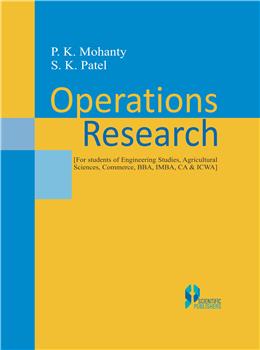1. Introduction
Introduction and Historical Development-
Definitions- Applications- Scope- Models in Operations Research- Classifications of Models- Methods of Solving or Models- Steps in or Models- Benefits of or- Limitations of or- Features of or Solutions- or Techniques
2. Linear Programming- Graphical Approach
Introduction- Terms Used in LPP- Advantages of LPP- Limitations of LPP- LP Model Formulation- General Statement in LPP- Assumptions Underlying LPP Model Formulation- Graphical Approach- Maximization Case- Minimization Case- Binding & Non-Binding Constraints- Redundant Constraint- Multiple Optimal Solution- Infeasibility- Unboundedness
3. Linear Programming - Simplex Method
Introduction- Comparison Between Graphical & Simplex Method- Conditions for Simplex Method- Steps for Simplex Method- Slack & Surplus Variables- Maximization Problem- Problem Standardisation- Important Definitions - Initial Basic Feasible Solution(IBFS)- Gauss Elimination Method- Optimum, Degenerate, Nondegenerate Solution- Test for Optimality- Minimization Problem- Artificial Variable Technique(Big M Method)- Two Phase Simplex Method- Dual Simplex Method- Difference Between Simplex & Dual Simplex- Problems On Mixed Constraint, Multiple Optimal Solution, Infeasible Solution, Unbounded Solution, Degeneracy- Methods To Resolve Degenaracy- Shadow Price
4. Duality and Sensitivity Analysis
Introduction- Canonical Form- Standard Form- Primal Dual Relationship- Structural Similarity- Sensitivity Analysis- Post Optimality Analysis- Parametric Programming- Change in Coefficients of Nonbasic Variables in Objective Function- Change in Coefficients of Basic Variables in Objective Function- Change in RHS Constraints- Change in Technological Coefficients Of Nonbasic Variables- Addition of New Constraint
5. Transportation Problem
Introduction- Transportation Model- Important Definitions - Feasible Solution- Basic Feasible Solution- Nondegenerate Basic Feasible Solution- Optimal Solution- North West Corner Rule- Least Cost Method or Matrix Minima Method- Vogel’s Approximation Method (Vam) - Stepping Stone Method- Modified Distribution Method (Modi)- Unbalanced Transportation Problem- Maximization in Transportation Problem- Degeneracy in Transportation Problem
6. Assignment Problem
Introduction- Difference Between Transportation & Assignment Model- Hungarian Method- Unbalanced Assignment Problem- Maximization in Assignment Problem- Prohibited Assignment- Travelling Salesman Problem
7. Sequencing Problem
Introduction- Terminology- Assumptions- N Jobs Thru’ 2 Machines- Gantt Charts- Johnson's Rule- N Jobs Thru’ 3 Machines- N Jobs Thru’ K Machines- 2 Jobs Thru’ K Machines- Graphical Solution
8. Decision Theory
Introduction- What is Decision- Two Phases of Decision Making- Steps in Decision Making- Characteristics of Decision Making- Decision Making Circumstances- Terminology- Decision Under Uncertainity- Maximax, Maximin, Minimax, Minimin, Laplace, Hurwicz Criteria, Savage Criteria- Decision Under Risk- Emv- Eol- Evpi- Eppi- Decision Tree- Roll Back Process- Advantages & Limitations of Tree Approach
9. Game Theory
Introduction- Classifications- Pure & Mixed Strategy- Two Person Zero Sum Game- Saddle Point- Dominance Rule- Subgame Method- Graphical Method- Iterative Method of Approximate Solution- Linear Programming Approach
10. Simulation
Introduction- Classifications- Advantages- Limitations- Monte Carlo Simulation Technique- Generation of Random Numbers
11. Queueing Theory
Introduction- Historical Development- Input Source- Queue- Service Discipline- Service Mechanism- System Output- Customer Behaviour- Terminology- Steady, Transient and Explosive States- Distributions of Arrival and Service Time- Single Server Poisson Arrival With Exponential Service Infinite Population- Cost Analysis- (M/M/C): Gd / - /- Multi Channel Queueing Theory- (M/M/1): Gd/M/- (M/Ek/1): Fcfs / - / - Poisson Input & Constant Service Time
12. CPM / Pert
Introduction- Why Pert/CPM- Characteristics Of Pert/CPM- Terminology- Network Construction- Estimation Of Activity Time- Probability of Achieving Completion Data- Time Cost Relationship (Crashing)- Time Cost Optimization- CPM Updating- Resource Allocation- Resource Levelling- Resource Smoothing
13. Inventory Control
Introduction- Classification- Why Inventory- Advantages- Factors in Inventory Control- Costs Involved in Inventory- Systems in Inventory Control- P, Q, Pq, Abc, Xyz, Ved, Sde, Hml, Nmg, Fnsd Analysis- Economic Order Quantity- Functions- Inventory Level- Inventory Models- Eoq With Uniform Demand- Eoq With Several Production Runs Of Unequal Length- Eoq With Non instantaneous Stock Replenishment - Stock Outs- Eoq With Instantaneous Production And Variable Order Cycle- Eoq With Instantaneous Production & Fixed Order Cycle- Eoq With Gradual Supply & Shortages Allowed- Eoq With Price Breaks- Eoq With More Than One Price Break- Reordering Systems- Buffer Stock And Reordering Level- Periodic Inventory Ordering System- Two Bin System
14. Integer Programming
Introduction- Cutting Plane Algorithm- Gomory’s Fractional Cut- Branch & Bound Method
Selected References

